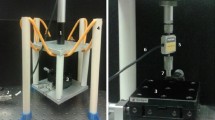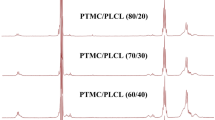Abstract
The degradation behavior of biodegradable multiblock copolymers (PDC) containing poly(p-dioxanone) hard segments (PPDO) and crystallizable poly(s-caprolactone) switching segments (PCL) synthesized via co-condensation of two oligomeric macrodiols with an aliphatic diisocyanate as junction unit was explored in in vivo and in vitro experiments. The in vitro experiments for enzymatic degradation resulted that the poly(s-caprolactone) segments are degraded faster, than the poly(p-dioxanone) segments. During degradation the outer layer of the test specimen becomes porous. Finally non-soluble degradation products in form of particles were found at the surface. This observation is in good agreement with the in vivo studies, where the non-soluble degradation products in the periimplantary tissues showed a diameter of 1–3 micron.
Similar content being viewed by others
References
D. Hofmann, M. Entrialgo, K. Kratz, A. Lendlein, „Knowledge-based approach towards hydrolytic degradation of polymer based biomaterials”, Adv. Mat. DOI:10.1002/adma.200802213, published online May 4 2009.
A. Lendlein, S. Kelch, Angewandte Chemie International Edition 41, 2034 (2002).
M. Behl, A. Lendlein, Soft Matter 3, 58 (2007).
A. Lendlein, R. Langer, Science 296, 1673 (2002).
K. Kratz, U. Voigt, W. Wagermaier, A. Lendlein, in Advances in Material Design for Regenerative Medicine, Drug Delivery, and Targeting/Imaging, edited by V. P. Shastri, A. Lendlein, L-S. Liu, A. Mikos, S. Mitragotri 1140-HH03-01, Mater. Res. Soc. Symp. Proc. Volume 1140E, Warrendale, PA (2009).
R. Mohr, K. Kratz, T. Weigel, M. Lucka-Gabor, M. Moneke, A. Lendlein, Proceeding of the National Academy of Science of the United States of America 103 (10), 3540–3545 (2006).
A. Kulkarni, J. Reiche, J. Hartmann, K. Kratz, A. Lendlein, European Journal of Pharmaceutics andBiopharmaceutics 68 (1), 46–56 (2008).
J. Reiche, A. Kulkarni, K. Kratz, A. Lendlein, Thin Solid Films 516, 8821–8828 (2008).
Bakker D, van Blitterswijk CA, Hesseling SC, Daems ThW, Grote JJ. J. Biomed Mater Res 24: 277 (1990).
Zajaczkowski MB, Cukierman E, Galbraith CG, Yamada KM. Tissue Eng 2003; 9: 525 (2003)
Acknowledgments
Authors are grateful to the German Federal Ministry of Education and Research for providing financial support within the BioFuture Award No. 0311867.
Author information
Authors and Affiliations
Rights and permissions
About this article
Cite this article
Hiebl, B., Kratz, K., Fuhrmann, R. et al. In vivo degradation behavior of PDC multiblock copolymers containing poly(p-dioxanone) hard segments and crystallizable poly(ε-caprolactone) switching segments. MRS Online Proceedings Library 1190, 0605 (2009). https://doi.org/10.1557/PROC-1190-NN06-05
Published:
DOI: https://doi.org/10.1557/PROC-1190-NN06-05




